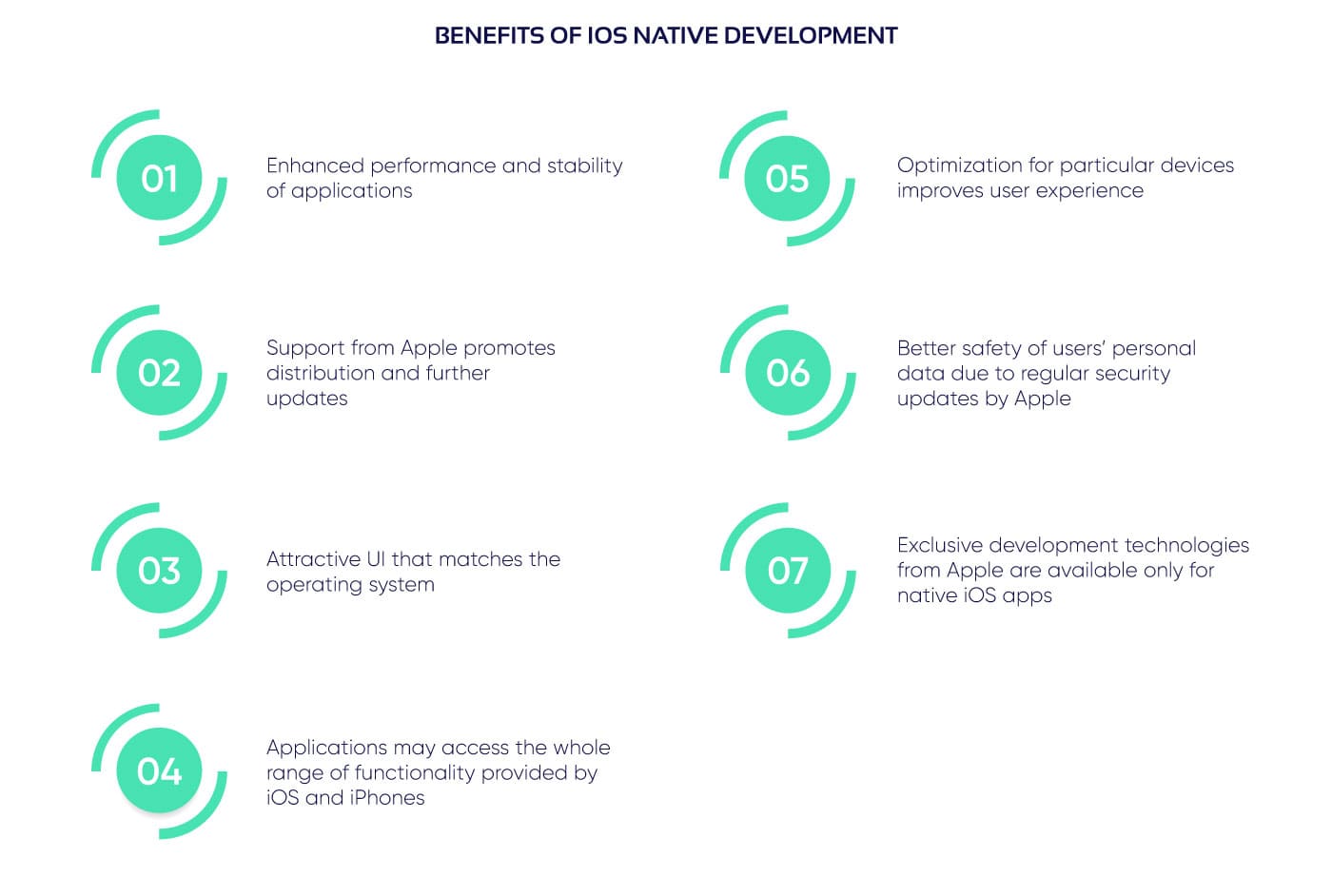iPhones are traditionally one of the best-selling smartphone brands in the world, and the App Store remains a lucrative target for software developers, despite the fact that Apple’s share on the global smartphone market is about 10%. For this reason, iOS native application development is a highly demanded area that attracts numerous investors and software specialists. Let us review the advantages of native iOS apps and see what opportunities they provide for developers and users.
What Is Native iOS Development?
Native development is the approach to software building that focuses on one mobile operating system: primarily iOS or Android. This method enables full utilization of built-in features included in iOS and iPhones and offers other development benefits which will be discussed in more details below.
The examples of native iOS apps include a large variety of official and third-party clients for many popular web services, social networks, as well as custom analogs of default iOS programs. While some service owners still prefer hybrid apps in order to save money by providing a single application for both Android and iOS systems, others aim at maximizing performance and quality with native applications for iPhones.
Advantages and Drawbacks of the Native Approach to iOS Development
Developing native mobile applications offers multiple unique perks unavailable for hybrid and cross-platform software. Here are several advantages linked to program development, support, and marketing, as well as user experience-related benefits of native mobile iOS apps.
- Among hybrid, native, and web applications, native software offers the best performance on a given platform.
- If they satisfy the requirements and are published according to Apple’s guidelines, iOS native apps enjoy the official support from the App Store, which is beneficial for developing their updates, as well as for their overall distribution and customer service.
- Native applications for iPhones are built using Apple’s software development kit and, thus, have attractive and consistent user interfaces that correspond to the general style of the operating system and other native iOS applications.
- iPhone native applications may access the whole set of features provided by both iOS and smartphone hardware, including computing power, camera, AI features, etc.
- Native applications for iOS offer better user experience as they are optimized for particular device models and do not have to support a large variety of possible models, brands, operating system versions, screen resolutions, and so on, as compared to Android native software.
- An additional benefit resulting from Apple’s support is the increased safety and quality of native iOS applications in comparison with their hybrid or web counterparts, ensured by regular performance and security fixes provided directly by Apple.
- Only native apps for iOS may be developed using Apple’s updated libraries, frameworks, APIs and other components, such as ARKit, Metal, SpriteKit, etc.
However, there are also several disadvantages associated with iOS native app development that are worth mentioning for the sake of unbiased description. While they do not negate the numerous benefits of native apps for iOS listed above, these drawbacks must be taken into consideration.
- IPhone native app development requires more time and funds, and the resulting software generally covers only a fraction of the possible target audience, as compared to hybrid or web software.
- Since the development cost is high, it may be more difficult to find potential business investors for a native iOS app startup.
The necessity to follow the official guidelines may stall the development process but will ultimately become beneficial for an application. Also, keep in mind that you need the iOS Developer Account that has a yearly fee of $99 to publish applications in the App Store. Besides, the App Store has a 30% commission rate regardless of the app type.
Development Tools and Technologies for Native iOS Software
All the abovementioned benefits can be implemented with the help of specific technologies created particularly for the needs of iOS software developers. To describe them as briefly and clearly as possible, let’s make a “lightning round” and get some short answers.
Which programming language is used for developing native iOS apps?
Currently, there are two: a relatively modern Swift and a veteran Objective-C which appeared in 1984. Despite its age, Objective-C is still widely used and, under certain conditions, may be on par with Swift in terms of effective development. This results from the ability of Objective-C to use code written in the C language, particularly an immense bulk of existing solutions for various functional needs. However, in terms of future perspectives, Swift is much more attractive as a core programming language for iOS.
What editor is used for writing native apps for iOS?
To create iOS applications, programmers need Xcode, as this tool comprises an integrated development environment with a graphical interface. Basically, it is an all-in-one package that includes the Software Development Kit for iOS, as well as essential frameworks, compilers, and other tools. Keep in mind that Xcode runs only on macOS.
Another IDE for native iOS development is called AppCode, and it’s fully compatible with Xcode. Alternatively, coders can develop iOS software on Windows 10 using Xamarin Live Player for Visual Studio; though some stages of development still require a Mac computer.
What is the framework for iPhone native app development?
Cocoa Touch is a comprehensive framework specifically designed for developing iPhone native applications, as well as solutions for iPad, iPod Touch, Apple Watch, and Apple TV. Similar to Xcode, Cocoa Touch is not a single tool but rather a software suite with multiple components. It contains several frameworks such as Foundation Kit Framework, UIKit Framework, Twitter Framework, and others that serve various development needs.
Summary
While native applications for iOS have their share of drawbacks, including high cost and reduced target audience, they also offer undeniable benefits both for developers and users. The most important of them are improved performance and user experience, as well as official support from Apple. Ultimately, the “native” approach to iOS software development leads to higher customer satisfaction, more downloads, better App Store ratings, and, as a result, ensure better profitability of an application. If you want to order a native iOS app with such benefits, contact our team and get an optimal solution for your business needs!




